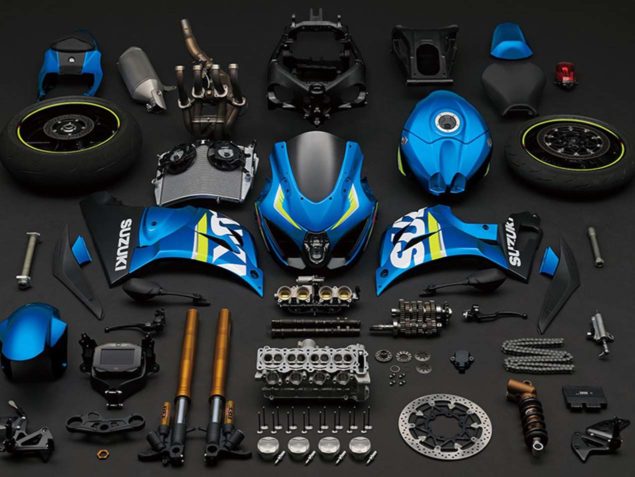We have had to wait nearly an entire year for Suzuki to finalize and release its new superbike, after first teasing us at the 2016 EIMCA show with it. But today at INTERMOT, the 2017 Suzuki GSX-R1000 is finally ready for primetime.
Because Suzuki already teased us the new GSX-R1000 a year ago, much about the machine is already known. But, for a proper plot twist, there will in fact be two variations of the Suzuki GSX-R1000 for 2017, with a higher spec 2017 Suzuki GSX-R1000R debuting as well.
For the 2017 Suzuki GSX-R1000 base model, of course everything is brand new. The inline-four engine on this liter-bike features a variable valve timing (VVT), a first in the superbike segment. Peak power is just shy of 200hp, with Suzuki claiming 199hp and 86.7 lbs•ft of torque.
The crown jewel of the electronics package is a six-axis IMU, which brings a 10-level traction control system, riding modes, cornering ABS, launch control, up-and-down quickshifts to the once “King of Superbikes” (the latter three items being on the GSXR-1000R).
With a wet weight of 441 lbs, the 2017 Suzuki GSX-R1000 is in the hunt to reclaim that crown, making this a strong return for the Japanese brand in the superbike segment.
Although it is not new information, it is worth mentioning that Suzuki ingeniously developed a mechanical variable valve timing system, largely to skirt around rules in the MotoGP Championship that were designed to prevent such technology coming into the series.
This VVT uses ball bearings that move along the cam gear, and change their orientation as it spins faster. This then changes the gearing for the intake timing, and creates more power on the top end, roughly 5% or 10hp.
This same theory of design resides in the 2017 Suzuki GSX-R1000, and it truly is an elegant solution to a complex task – one we’ve seen other brands, like Honda and Ducati, struggle to implement effectively on motorcycles.
We would say that it will be most intersting to see how the VVT works on the Suzuki GSX-R1000 in the real world, though Suzuki’s progress in MotoGP might be a good barometer. Needles to say, we have high hopes.
What the VVT does for top-end power, the Broad Power System does for the low-end. Suzuki’s Broad Power System uses a finger-follower valve train and also manages how the exhaust works, maximizing both for peak torque from the engine at lower rpm ranges.
Suspension on the 2017 Suzuki GSX-R1000 is handled by Showa’s Big Piston Fork, and its matching shock absorber (the GSX-R1000R gets Showa’s Balance Free Fork and Balance Free Cushion shock).
Continuing the changes, the main chassis and rear subframe are roughly 5 lbs lighter than their predecessors, combined.
The 2017 Suzuki GSX-R1000 is expected to be available in dealerships, early 2017. Meanwhile, the 2017 Suzuki GSX-R1000R will debut later in 2017. We look forward to riding them both.
Source: Suzuki
As always, Asphalt & Rubber will covering all the new bikes debuting at the INTERMOT and EICMA shows this year. Be sure to follow our coverage for the most recent news and photos.























Comments